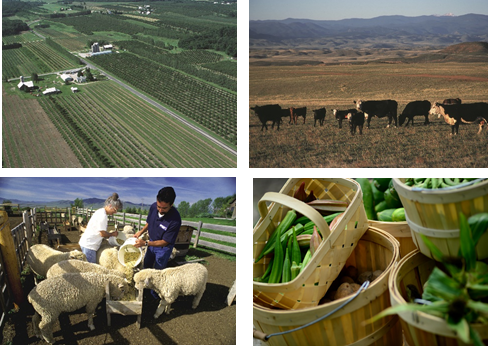The Duty of Biotechnology in Agriculture Advancements
The Duty of Biotechnology in Agriculture Advancements
Blog Article
Enhance Agricultural Performance With High-Quality Water Soluble Polymers
These polymers use a range of benefits that can revolutionize typical farming techniques, from improving water retention and efficiency to optimizing soil structure and nutrient distribution systems. By using the power of innovative polymer remedies, farmers can possibly unlock brand-new pathways in the direction of attaining higher plant returns while mitigating environmental influences.

Benefits of Water-Soluble Polymers
Water-soluble polymers provide a wide variety of advantages in farming applications because of their improved water retention buildings and ability to enhance dirt structure. Agriculture. These polymers, when contributed to the dirt, can substantially boost water holding ability, lowering the regularity of irrigation called for by plants. By creating a gel-like compound when blended with water, water-soluble polymers develop a storage tank that slowly releases moisture to plant roots, making sure an extra consistent water throughout droughts
Additionally, these polymers aid in preventing dirt erosion by binding soil fragments with each other, thus enhancing dirt structure and security. Enhanced dirt framework permits far better root penetration and oygenation, promoting healthier plant growth and greater crop yields. Water-soluble polymers additionally help in nutrient retention by lowering leaching, making sure that necessary nutrients continue to be readily available to plants for a longer duration.
Improved Water Retention and Performance
Enhancing agricultural water retention and performance via the consolidation of sophisticated polymer innovations has actually become an extremely important focus in contemporary farming methods. Water-soluble polymers play a critical function in improving dirt framework, boosting water seepage, and lowering water dissipation prices. By forming a thin movie on the dirt surface area, these polymers help to stop water overflow and boost the soil's water-holding capability, making certain that plants have accessibility to an ample supply of water.
In addition, using premium water-soluble polymers can considerably decrease the frequency of watering, as they boost the dirt's capability to maintain dampness for longer periods. This not just preserves water however likewise decreases the energy and labor prices connected with watering practices. In addition, improved water retention and efficiency result in better nutrient uptake by plants, causing improved crop yields and overall agricultural efficiency.
Improved Nutrient Delivery Solution
Given the considerable impact of top notch water-soluble polymers on boosting water retention and effectiveness in farming, the emphasis currently shifts towards optimizing nutrient delivery systems to additionally boost crop growth and yield. Boosted nutrient delivery systems play a vital duty in guaranteeing that plants get the required nutrients in a type that is easily offered for uptake, advertising their total health and efficiency. By incorporating water-soluble polymers into nutrient delivery systems, the performance of nutrient uptake by plants can be dramatically enhanced.
One key benefit of using top notch water-soluble polymers in nutrient delivery systems is their ability to manage the launch of nutrients, guaranteeing a regulated and consistent supply to plants over a prolonged period (Agriculture). This regulated launch mechanism assists avoid nutrient leaching and overflow, thereby making best use of vitamins and mineral usage by crops and reducing environmental influence

Dirt Framework Optimization Methods
Maximizing dirt framework is critical in modern agriculture for making the most of plant returns and promoting lasting land monitoring practices. Dirt framework optimization techniques play more a critical duty in making certain that soil provides an ideal environment for plant growth. One crucial technique is the enhancement of raw material, such as garden compost or manure, which helps improve soil framework by boosting its water-holding capability and nutrient retention.
In addition, exercising minimum tillage or no-till farming can stop soil compaction and promote the growth of a healthy dirt framework. Cover cropping is an additional effective strategy that includes planting plants particularly to improve the dirt and secure, protecting against erosion and improving soil framework.
Furthermore, executing crop rotation approaches can help break bug and disease cycles, while also boosting soil framework through the varying origin structures of various plants. Overall, employing these soil framework optimization strategies can bring about increased farming efficiency, lowered ecological impact, and long-term sustainability in farming methods.
Sustainable Solutions for Plant Yields

To deal with the obstacles of making the most of plant yields while promoting lasting land administration methods, exploring lasting options becomes essential in modern agriculture. One lasting remedy for boosting crop returns is the usage of accuracy farming techniques.
In addition, promoting crop rotation and cover cropping can help preserve soil health and wellness, lower disintegration, and enhance vitamins and mineral cycling, ultimately adding to read this article higher returns in time. Integrated bug monitoring methods also play an essential role in lasting plant manufacturing by lessening the reliance on chemical pesticides and promoting all-natural parasite control methods.
Furthermore, spending in research and technology for creating drought-resistant crop ranges and climate-resilient farming methods can assist minimize the influence of environment modification on farming while ensuring regular yields in the face of ecological challenges. By taking on these lasting solutions, farmers can accomplish greater crop yields while securing the health of the land for future generations.
Final Thought
To conclude, making use of top quality water-soluble polymers in agriculture supplies numerous advantages such as enhanced water retention, boosted nutrient distribution systems, and optimized dirt structure. By applying sustainable options for plant returns, farmers can dramatically enhance agricultural efficiency and efficiency. Agriculture. Water-soluble polymers offer a affordable and ecologically friendly method to improve the general efficiency of farming techniques, causing far better outcomes for both farmers and the environment
These polymers use a range of benefits that can revolutionize traditional farming approaches, from boosting water retention and performance to optimizing soil structure and nutrient delivery systems.In addition, these polymers assist in stopping soil erosion by binding dirt particles with each other, therefore boosting soil structure and security. By developing a slim movie on the soil surface area, these polymers aid to avoid water runoff and enhance the soil's water-holding ability, guaranteeing that plants have accessibility to Website an ample water supply.
Dirt structure optimization methods play an essential function in making sure that dirt supplies an ideal setting for plant development.In conclusion, the usage of premium water-soluble polymers in farming supplies many benefits such as better water retention, improved nutrient delivery systems, and maximized soil framework.
Report this page